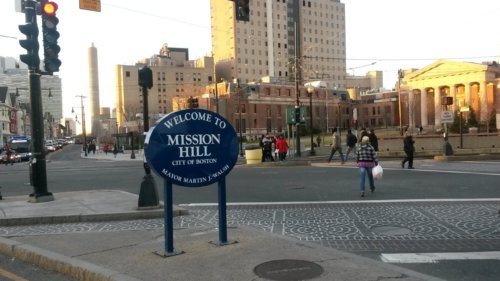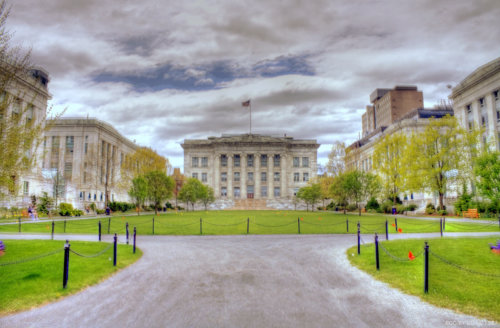Gown vs. Town: Opposition to Harvard's Development in Mission Hill
In the mid-1960’s, Harvard University purchased twenty acres of land in the diverse and predominantly working-class Mission Hill section of Roxbury in the hopes of expanding its presence in the Longwood Medical Area. Having witnessed the disastrous effects of redevelopment in the West End and successful community intervention in other Boston neighborhoods, Mission Hill residents, with the help of young activists from Harvard itself, were able to secure affordable housing for over a thousand people.
Harvard University and the residents of Boston’s Mission Hill neighborhood experienced a typical town and gown relationship heading into the 1960’s. Living next to the Longwood Medical Area, Mission Hill residents had to endure the congestion and noise caused by traffic surrounding medical facilities, some of which were owned by or affiliated with Harvard University, but they also benefited from the jobs created by the same facilities. These employment opportunities were vital to local working class residents, many of whom lived in public or aging housing, and of course Harvard and other operators of Longwood hospitals benefited from the nearby labor pool.
This relationship took a turn for the worse on January 3, 1962, when in his annual address to the Commonwealth, Massachusetts Governor John A. Volpe voiced his support for an expansion of the Harvard University-affiliated Mental Health Center located in the Longwood Medical Area. Seven days later, the Massachusetts House conducted a hearing on a bill which would authorize the taking of land by the Public Health Department to support the expansion. As if these were not warning signs enough for Mission Hill residents, on June 17, 1962 Dr. Erich Lindemann, Harvard professor of psychiatry (and future namesake of the Lindemann Building at 25 Staniford Street in the West End), happened to give a lecture at the Mental Health Center titled, “Mental Health and the Metropolis,” with a focus on the effects of relocation on West Enders.
Mission Hill residents had already encountered urban renewal efforts in the form of the Whitney Redevelopment Project in 1958, a high-rise development on a much smaller scale than that in the West End, and quickly organized to resist the State and Harvard-sponsored expansion of the Mental Health Center and the planned removal of thirty homes. The culminating moment of the protest occurred on December 17, 1964 when 3,000 Mission Hill residents marched on the Massachusetts State House. One of the group’s leaders, Reverend Edward McDonough, argued that “city planners can build beautiful buildings, but they can’t build cohesive neighborhoods.” Upon witnessing this impressive show of community force, state politicians pulled back their support and effectively killed the project.
Harvard’s expansion plans, however, were not over. Almost three years later, on July 14, 1967, the Boston Globe reported a new Harvard venture in Longwood named the Affiliated Hospitals Project. The goal of this new development was to consolidate three Harvard Medical School-affiliated teaching hospitals under one roof. The location for this new complex was not identified at the time of the report, but Harvard had already targeted a site in the Mission Hill area along Huntington Avenue where it had begun to stealthily purchase 20 acres of property. Beginning in the spring of 1969, Harvard began issuing eviction notices to 182 tenants living in these properties in order to clear land for the new hospital. This time the university’s actions triggered a hostile response not only from Mission Hill residents, but from within its own ranks.
Upon hearing of the eviction notices sent by their university, three Harvard student activists, Hayden Duggan, Doug Levinson, and Jeanne Neville, went to Mission Hill to assist the community. After recruiting a number of neighborhood supporters through a door-to-door campaign, and with the assistance of Urban Planning Aid (a community action organization founded by other students and teachers from Harvard and M.I.T.), “The Harvard Kids.” as they were now called, created the Roxbury Tenants of Harvard (RTH). RTH would become the leading community voice in opposition to Harvard’s new plans, but initially Harvard refused to meet or negotiate with RTH members. It would take persistent pressure, including a demonstration on December 17, 1969 in front of the Harvard Medical School, which included over a hundred members of the Harvard University community, to finally force the university’s hand.
After years of negotiations with Harvard, RTH and the Mission Hill community finally won substantial concessions. Harvard’s final $20 million development plan would now include the rehabilitation of 300 units of existing housing and the creation of Mission Park, a new 500 unit housing complex built along Huntington Avenue. In honor of their efforts, three of the buildings were named Duggan House, Levinson Tower, and Neville House after the “Harvard Kids.” Though originally owned by Harvard and managed by RTH, Harvard ultimately transferred its ownership of Mission Park to RTH in 1999. Today Mission Park continues to serve as a major resource for Mission Hill residents, and a tribute to the neighborhood’s stand against aggressive development.
Article by Bob Potenza, edited by Sebastian Belfanti
Sources: City of Boston, “Whitney redevelopment project relocation plan”. August 28, 1959; Cobb, Carl. “Harvard to Build $22m 800-Unit Housing Complex.” Boston Globe (1960-), Sep 15 1972, p. 1. ProQuest. Web. 9 Mar. 2023 .; The Boston Globe, Boston, Massachusetts, Wednesday, January 03, 1962; The Boston Globe, Boston, Massachusetts, Monday, January 08, 1962; The Boston Globe,Boston, Massachusetts, Sunday, June 10, 1962; The Boston Globe,Boston, Massachusetts · Friday, July 14, 1967; The Boston Globe, December 18, 1964.;Vrabel, Jim. A People’s History of the New Boston. Amherst: University of Massachusetts Press, 2014.













